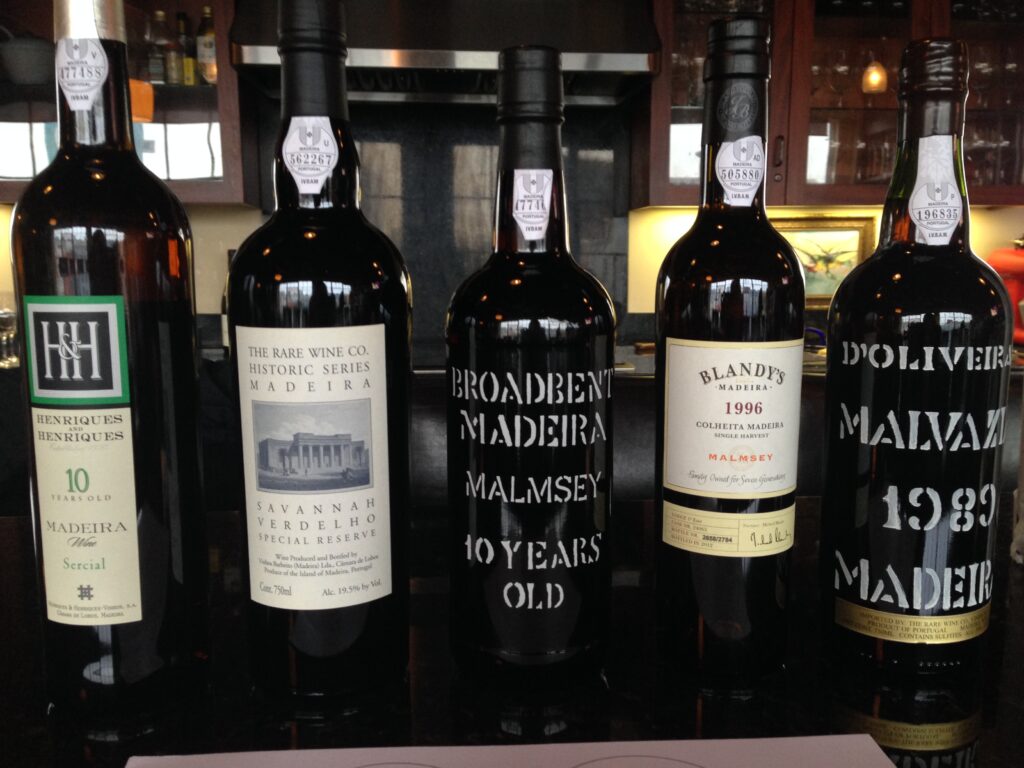We were thrilled to host this Madeira Master Class at SFWC, led by professionals from The Madeira Wine Institute – the governing body of winemaking on the island of Madeira, Portugal. Madeira is a fortified wine known for its longevity – but did you know the best Madeira can last 300 years? Rui Falcao, our instructor, told us about the oldest Madeira he’s tried, which was from 1715. It was not only good, but very good – nowhere near tired or gone. How does this tiny, mountainous island whose subtropical climate is always 70 degrees produce one of the world’s most indestructible wines? Acidity! Like Champagne, Madeira’s wine grapes produce extremely acidic wines that are undrinkable in their normal, vinified state. But this acidity provides the backbone of a wine balanced by natural sugar levels and the addition of neutral spirit to raise the alcohol from about 9% to 18%. With the right amount of aging, a beautiful, complex wine emerges.
Madeira is always a single varietal wine. The 5 main permitted varietals vary in natural sweetness, so their wines will usually follow suit. Sercial is a always a dry wine; Verdelho – medium dry; Boal/Bual – medium sweet; Malvasia/Malmsey – sweet/rich; Tinta Negra is the only red varietal, vinified as a white, and it can be any level of sweetness. Though it accounts for 82% of Madeira production, it used to not be talked about, but as recently as the day of this class it had been recognized as a Noble grape varietal and will be included on the label going forward.
Madeira has a total of just 900 acres of vines. Vineyards are managed separately from the wineries, and there are only 8 Madeira wineries in existence. One of these opened 3 years ago and it was the first new winery in 60 years. Clearly, Madeira winemaking is a very old tradition. (Fun fact: the fathers of the U.S. Constitution toasted its signing with Madeira!) The Madeira Wine Institute does all of the analytics on each wine and tastes them before bottling to make sure the wine matches its proposed labeling criteria. After a blind tasting, an approval allows the winery to bottle and sell the wine. Madeira wines are either a blended style (meaning a blend of different years, not grapes); a Colheita single harvest – also known as a “baby vintage” that must be aged for a minimum of 5 years to be labeled as such; or a Frasqueira/Vintage – which must be aged for a minimum of 20 years to be labeled with that vintage.
The tasting included a wonderful sampling across these grape varietals and aging categories. We learned that Madeira should be served cold, and one shouldn’t try to follow it with any other wine – the finish is long and lingering. Despite the “sweet” character of many Madeiras, the bracing acidity actually balances that sweetness, making it a friendly wine on its own or with food.
Typical Madeira aromas include toasted almond, caramel, molasses and raisin. My favorite was the Colheita 1996, with its honey and orange blossom character; the finish went on forever. The Malvasia 1989 was also a treat, with burnt orange peel and caramel.

Wine List:
- H&H Sercial 10 Años
- The Rare Wine Co. Savannah Verdelho
- Broadbent Malvasia 10 Años
- Blandy’s Colheita 1996
- D’Oliveiras 1989 Malvasia
Thank you to Rui and the Madeira Wine Institute for choosing SFWC to host this informative and delicious tasting!
-Melanie Solomon

